We fight a popular tomato disease using folk methods: how to treat tomatoes with iodine against late blight
It’s a shame and unpleasant when plant diseases nullify all the efforts of summer residents. Late blight is one of the most dangerous diseases of garden crops. It seems that nothing will interfere with the harvest, but then a misfortune arises in the form of the fungus Phytophthora infestans.
Don’t expect the plant to heal on its own; start treatment at the first sign. Find out how to treat tomatoes with iodine against late blight correctly and how effective this remedy is, read our article.
Briefly about late blight
Late blight – a fungal disease caused by a microorganism called late blight. It appears as red-brown spots that quickly grow over the entire surface of the plant. Then the plantings are covered with a light gray coating.
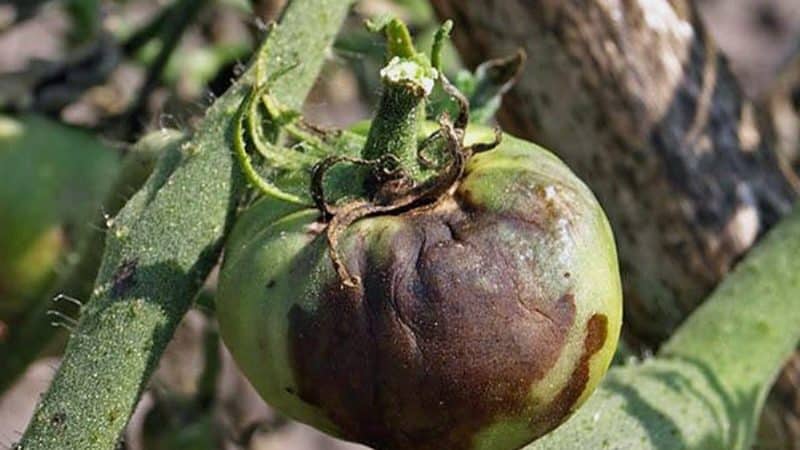
Breeders are constantly developing new varieties of tomatoes that are resistant to pathogens, but microorganisms also develop along with them. If previously late blight was detected on tomatoes no earlier than August, now some summer residents encounter it as early as early June.
Thanks to the evolution and mutation of late blight strains, chemistry is often powerless against new types of spores of this fungus. Then folk remedies come to the rescue. In our case, iodine.
Benefits of iodine
Gardeners have long used iodine not only as a top dressing, but also for disinfecting soil and seedlings.
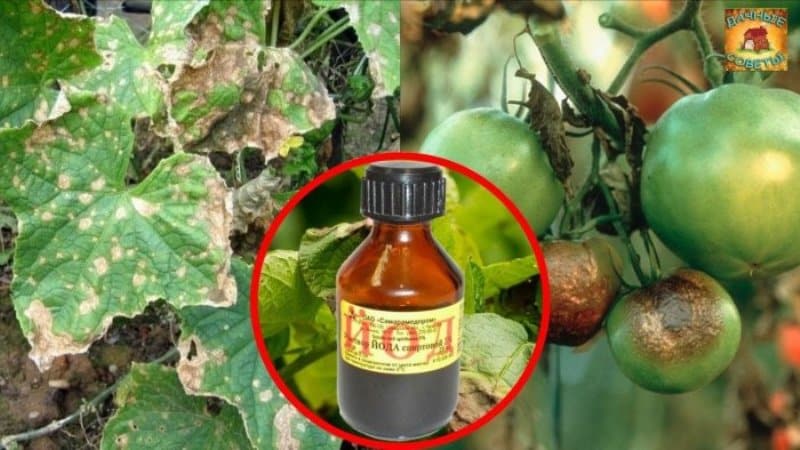
Reviews about its use are mostly positive:
- Increases seed germination.
- Helps seedlings to take root in a new place after transplantation.
- After feeding, the formed fruits acquire a bright red color, becoming more attractive and juicier.
- Promotes long-term storage of fruits.
- An excellent antiseptic, eliminates fungal diseases such as late blight and powdery mildew.
- Perfectly replaces nitrogen fertilizers, strengthening plant immunity.
Uses of iodine
The greenhouse and late blight are inextricably linked, so it is not enough to treat only the plants. At the first signs of late blight, it is recommended to spray the greenhouse with iodine solution.
An antiseptic can also be used as a preventive measure. To do this, open bottles of iodine are placed in the corners of the greenhouse. The liquid slowly evaporates, saturating the air in the greenhouse with it, which helps destroy microspores. For a 3x8 m greenhouse, five bubbles are enough.
In the fight against already manifested fungus, spraying tomatoes is carried out 2-3 times in order to obtain the desired effect. Treatment of bushes is combined with other methods of eliminating fungal diseases, for example, garlic infusion with potassium permanganate or saline solution.
Preparation of working solution
If you collected the fruits when there were no signs of late blight, but then noticed that the plants were starting to hurt, you should protect the collected tomatoes. To do this, heat 10 liters of water to a temperature of 50-60°C, add 10 drops of iodine tincture and pour this solution over the fruits for 5 minutes. Then it is dried and left to ripen.
Diseased plants are sprayed with combined mixtures with the addition of an antiseptic. Various additives enhance the effect of iodine tincture, forming a film on the surface of fruits and leaves - additional protection from pests.The supplements are also rich in minerals and amino acids and also act as additional nutrition.
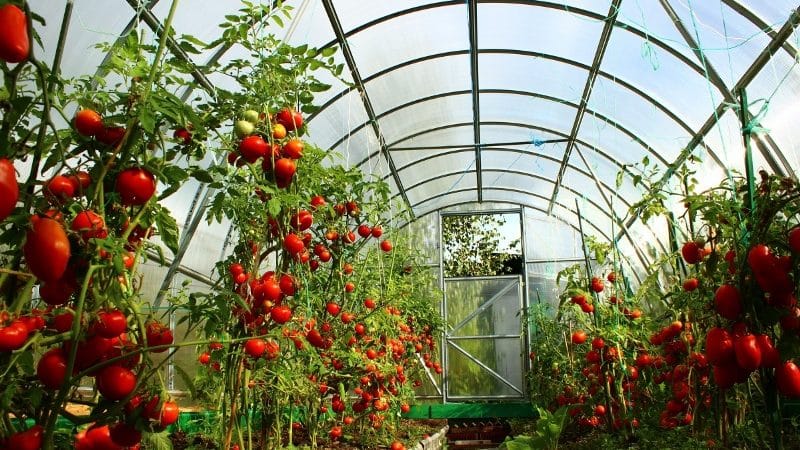
The most common solutions:
- WITH serum. Solution: add 1 tbsp to 10 liters of dairy product. l. tinctures.
- WITH milk. Mixture: add a glass of milk and 1 tsp to 10 liters of water. Yoda.
- With ash. Ingredients: for 10 liters of water, take 250 g of wood ash and 10 drops of antiseptic.
- With boric acid. Solution: dilute a teaspoon of boric acid in 2 liters of hot water, bring the amount of liquid to 10 liters, add 20 drops of iodine.
- With potassium chloride. Mixture: 40 drops of iodine tincture and 1 tbsp. l. dilute potassium chloride in a 10 liter bucket of water.
Rules for processing tomatoes
In case of tomato disease, treatment is carried out at intervals of two weeks in a greenhouse, in open ground once every 3-4 weeks. To prevent the occurrence of fungus, the product is used once every 15 days.
The mixtures are effective at all stages of tomato development and are suitable for open and closed ground.
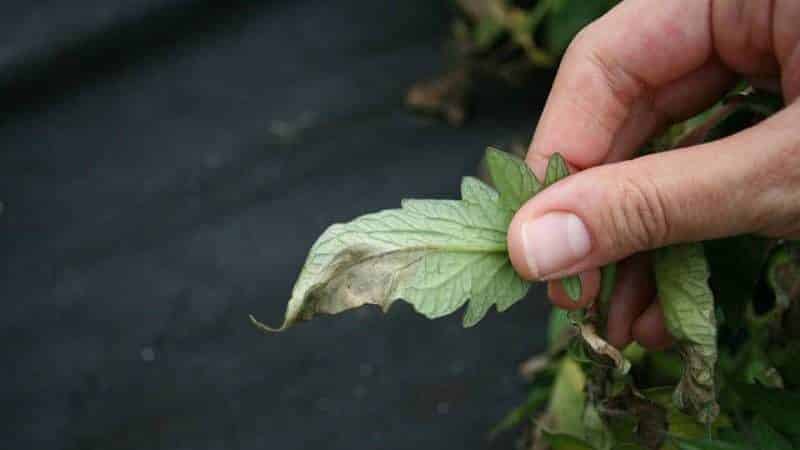
Basic rules of application:
- Use the diluted product immediately after preparation, spraying the plants through a fine sprayer.
- When spraying, try to get the liquid on the underside of the leaf, where the mixture is better absorbed.
- Pre-water the soil with plain water.
- Spray tomatoes early in the morning or evening to avoid direct exposure to sunlight.
- If tomatoes are grown outdoors, monitor the weather. During and after treatment for three days, it is advisable that there is no rain or strong wind. If necessary, repeat the treatment immediately after rain.
- When spraying in the greenhouse, ventilate thoroughly to avoid condensation.
The composition of the prepared solutions is safe for humans if the minimum protection requirements are met. The drugs are available and inexpensive. But people with hypersensitivity to the components used should use gauze bandages and rubber gloves. Care is required when working with iodine tincture, which, if spilled heavily on the skin, causes a slight burn.
The fruits can be eaten immediately after processing.
Prevention and iodine
Most summer residents are aware of the existence of diseases and take preventive measures in advance.
Greenhouse
In the greenhouse, the walls and soil are treated before planting. To do this, prepare a solution of 20 liters of water and 60 drops of antiseptic. Walls and beams are washed and sprayed in hard-to-reach places. Some people add a couple of crystals of potassium permanganate to the mixture for treating walls.
If the greenhouse was exposed to late blight a year earlier, the treatment is carried out twice, two weeks apart.
Priming
It is also recommended to disinfect the soil in the greenhouse and in open beds. Dilute 10 drops of iodine in 10 liters of water, pour plenty of soil and dig up.
Tips for summer residents and gardeners
To avoid harm from iodine treatment, follow these rules:
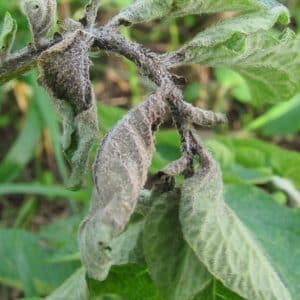
- When transplanting seedlings, treat no earlier than 10 days later. During this time, the tomatoes adapt to the new habitat and straighten their root system.
- If you have a disease, prepare the formulations based on the recipes given, without increasing the iodine concentration. The antiseptic can burn the root system and burn the leaves.
- Alternate additives in solutions. Fungus strains quickly adapt to drugs. And frequent use of boric acid leads to necrosis of leaves and distortion of fruits.
- Measure iodine with a medical pipette.
- Use water that does not contain chlorine. To do this, let tap water stand for 12-24 hours.
- Apply in dry and calm weather in the morning or evening.
- Pick off affected leaves and fruits and burn them. Do not store infected plants in compost bins.
Conclusion
Remember, prevention is the best cure. Carefully monitor the condition of your pets in the greenhouse or soil, and at the slightest suspicion, begin treatment or prevention. Then the question of how to fight the disease will not arise. But don't overdo it.
Iodine will eliminate infection, increase the plant’s immunity, and help bright and juicy fruits acquire a healthy color. But this does not mean at all that the more iodine in the solution, the better. Follow the recipe strictly, and then your harvest will be strong and healthy, the envy of your neighbors.